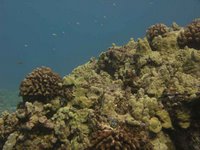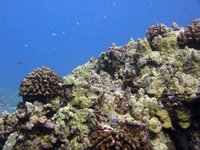One of the inherent problems with taking pictures underwater is that water either blocks, absorbs or reflects (I'm not sure if it's one or all of these - talk to a physicist, or at least someone smarter than I, if you want the straight scoop)certain wavelengths of light, and the deeper you go the less light is available, especially for photography. Red light is the first color to go and in general a blue cast to underwater photos is extremely noticeable.
Underwater photographers try to offset this through several methods... adding light with a flash or using a red lens to add red back in were the most common methods 'til recently. There can be problems with flash photography, 1- the light can still only penetrate so far and it takes a lot of strobe power to light up even 2 or 3 feet beyond the flash, and 2- if the flash is too close to the camera it will light up particulate matter in the water between the lens and your subject and you'll get white spots on your photos. Both of these are common experiences for underwater photographers when they first start out.
My early solution was just to get as close as possible and hope for the best... it actually worked pretty well for close stuff in clear water (for instance, the nudibranch pics in recent posts were all in macro with the onboard flash of my older camera). The trouble was if I was trying to take a wide shot, say of a reef or a person or two. In those cases I usually had a picture with a strong blue cast, or if using the flash, a dull photo with a lot of white spots. If you go out and pick up a cheap disposable underwater camera you will likely get a picture that might have a blue cast that looks like this.....

... even if you get a nicer camera you may end up with a photo that looks much the same if you use the automatic settings. I took this pic using the automatic settings. In any case, you'd need to be a photoshop genious to get a picture that looks close to realistic colorwise.
When I bought the housing for my newer camera, the housing would not allow me to access the pop up flash. I had to figure out the manual white balance. Most digital cameras will have both auto white balance and white balance settings for different lighting conditons... daylight, cloudy, etc... which will allow it to change the way it handles processing the image on the sensor. At some point several camera companies came up with menus that allowed you to manually set white balance by actually pointing the lens at something white and it would figure out the proper white balance and recalibrate the way it sees colors for those exact lighting conditons... this works FABULOUS underwater.
 This is pretty much the same photo as before, only this time I put the camera into manual white balance mode, showed it something white (I carried a white shop rag down with me, some people just use sand if it's relatively white), set the WB and then took the shot.... Pretty close to real.
This is pretty much the same photo as before, only this time I put the camera into manual white balance mode, showed it something white (I carried a white shop rag down with me, some people just use sand if it's relatively white), set the WB and then took the shot.... Pretty close to real. At that point you can go into your favorite photo editing program and do a single click on "Auto levels" or some other "instant fix" image adjustment and most programs will give you a darned realistic looking color. This third photo is taking the manual WB photo and then running the auto levels setting in Photoshop. Simple.
At that point you can go into your favorite photo editing program and do a single click on "Auto levels" or some other "instant fix" image adjustment and most programs will give you a darned realistic looking color. This third photo is taking the manual WB photo and then running the auto levels setting in Photoshop. Simple.Manual white balance only works for the specific lighting conditions it was set in, so you may have to change it when so much as a cloud passes over or you even go to a different depth. In some cases there just won't be enough light to get good color even with manual capabilities, but it's always worth a try if you have no other light source. It takes some thinking at first, but once you get practiced it's not all that hard to do it on the fly.
Be aware that not all digital cameras have manual WB capabilities, if shopping for a digital camera and housing for underwater, you'll definitely want one that can do it if you want the versatility for longer shots.
Hope this wasn't too confusing, or boring, but it's made a world of difference in my underwater photos. I'll probably not use it much once I have an extra grand or so for a nice strobe, but it's great for the available light stuff I'm doing now.
Aloha,
Steve
No comments:
Post a Comment